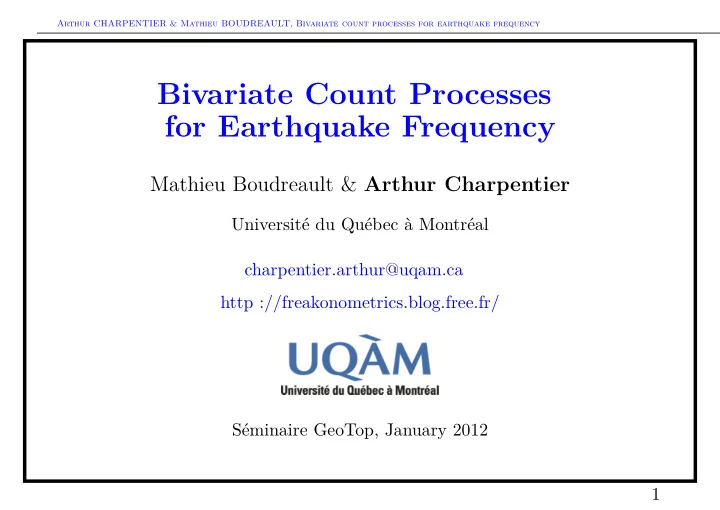

Arthur CHARPENTIER & Mathieu BOUDREAULT, Bivariate count processes for earthquake frequency Bivariate Count Processes for Earthquake Frequency Mathieu Boudreault & Arthur Charpentier Université du Québec à Montréal charpentier.arthur@uqam.ca http ://freakonometrics.blog.free.fr/ Séminaire GeoTop, January 2012 1
Arthur CHARPENTIER & Mathieu BOUDREAULT, Bivariate count processes for earthquake frequency Figure : Time and distance distribution (to 6,000 km) of large (5<M<7) aftershocks from 205 M ≥ 7 mainshocks (in sec. and h.). 2
Arthur CHARPENTIER & Mathieu BOUDREAULT, Bivariate count processes for earthquake frequency Motivation “ Large earthquakes are known to trigger earthquakes elsewhere. Damaging large aftershocks occur close to the mainshock and microearthquakes are triggered by passing seismic waves at significant distances from the mainshock. It is unclear, however, whether bigger, more damaging earthquakes are routinely triggered at distances far from the mainshock, heightening the global seismic hazard after every large earthquake. Here we assemble a catalogue of all possible earthquakes greater than M5 that might have been triggered by every M7 or larger mainshock during the past 30 years. [...] We observe a significant increase in the rate of seismic activity at distances confined to within two to three rupture lengths of the mainshock. Thus, we conclude that the regional hazard of larger earthquakes is increased after a mainshock, but the global hazard is not. ” Parsons & Velasco (2011) Figure : Number of earthquakes (magnitude exceeding 2.0, per 15 sec.) following a large earthquake (of magnitude 6.5), normalized so that the expected number of earthquakes before and after is 100. 3
Recommend
More recommend